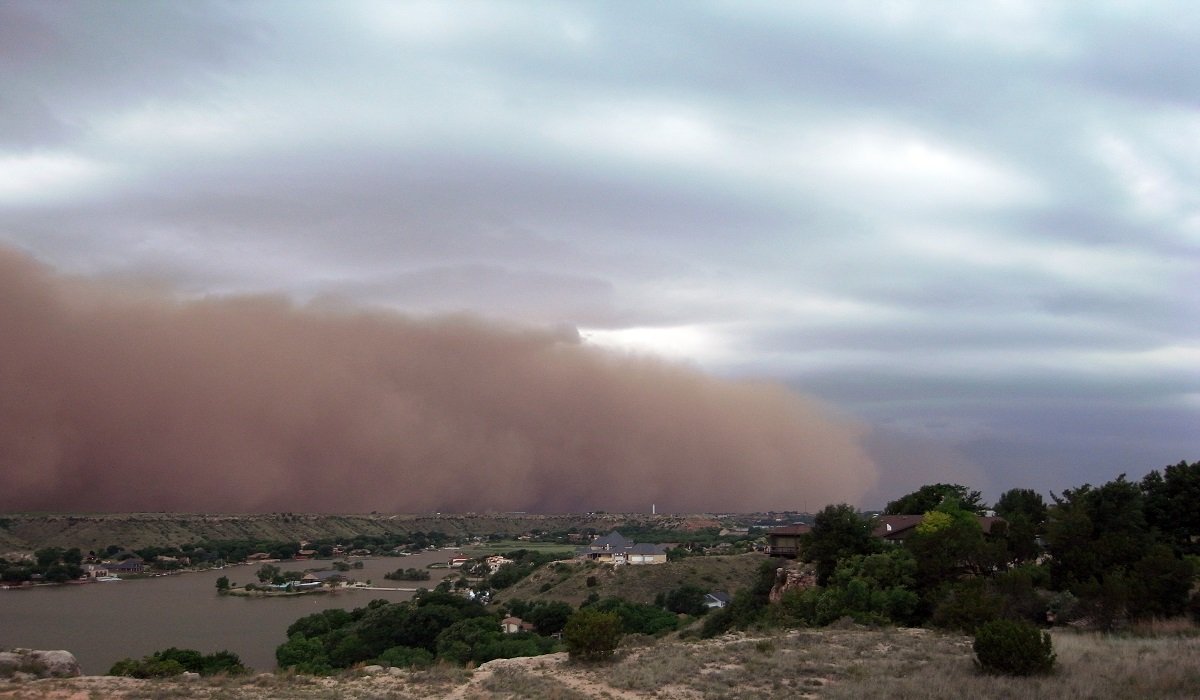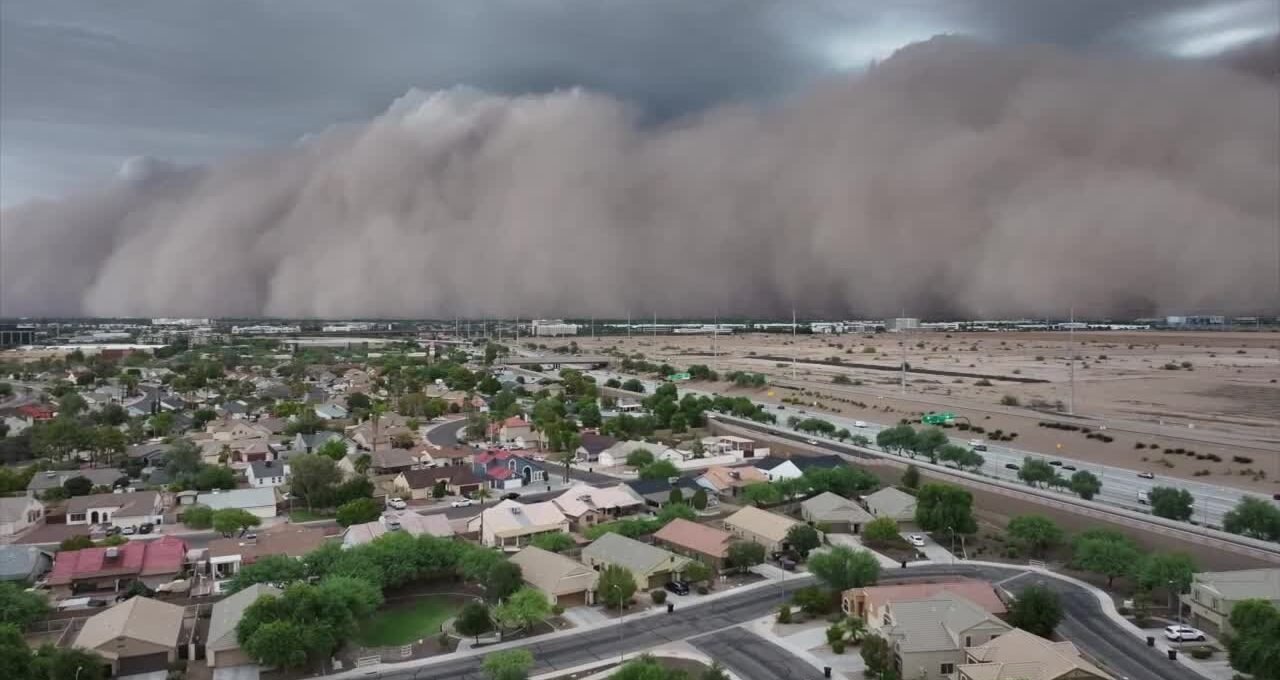When Nature Unleashes Its Raw Power
Phoenix, Arizona, experienced one of nature’s most dramatic spectacles on Monday, August 25, 2025, when a colossal dust storm, known locally as a haboob, swept across the metropolitan area. This towering wall of dust and debris transformed day into night within minutes, leaving residents in awe of the desert’s raw power while causing widespread disruption across the Valley of the Sun.
The Anatomy of a Haboob: Understanding Nature’s Desert Phenomenon
A haboob, derived from the Arabic word “habb” meaning “to blow furiously,” is a massive dust storm that occurs in arid regions worldwide. These natural phenomena are particularly common in the southwestern United States, especially in Arizona during the monsoon season. The recent Phoenix haboob represented the first major dust storm of 2025, marking what meteorologists described as one of the most significant weather events of the year.
These dramatic weather events form when intense thunderstorm downdrafts hit the ground and spread outward, picking up loose soil, sand, and debris in their path. The result is a towering wall of dust that can reach heights of several thousand feet and stretch for miles across the landscape. The Phoenix haboob exemplified these characteristics perfectly, creating an apocalyptic scene that left viewers both terrified and mesmerized.

A City Transformed: Monday’s Dramatic Weather Event
The dust storm that engulfed Phoenix on August 25th began as part of an active monsoon system that had been building throughout the day. As afternoon thunderstorms developed across portions of Arizona, the atmospheric conditions became ripe for haboob formation. What started as distant clouds on the horizon quickly evolved into a massive wall of dust that consumed the entire metropolitan area.
Witnesses described the experience as surreal, watching as the towering dust cloud approached like a slow-moving tsunami. The wall of dust, estimated to be thousands of feet high, moved across the landscape with deliberate intensity, swallowing everything in its path. As it reached the city, daylight vanished almost instantly, replaced by an eerie orange-brown darkness that transformed familiar neighborhoods into alien landscapes.
The storm system that produced this haboob was particularly powerful, combining the classic elements that make Arizona’s monsoon season so unpredictable and intense. The interaction between high pressure systems and moisture from tropical regions created the perfect atmospheric recipe for this spectacular natural display.
The Immediate Impact: Power, Transportation, and Daily Life Disrupted
The dust storm’s arrival brought immediate and widespread consequences for Phoenix residents and visitors. Power outages affected tens of thousands of homes and businesses throughout Maricopa County, with over 15,000 customers losing electricity as strong winds and reduced visibility created hazardous conditions for utility infrastructure. The combination of dust, wind, and subsequent heavy rainfall created a perfect storm of disruption.
Phoenix Sky Harbor International Airport, one of the busiest airports in the United States, experienced significant operational challenges as the haboob grounded hundreds of flights. The airport’s operations came to a standstill as visibility dropped to near zero, making it impossible for aircraft to safely take off or land. Passengers found themselves stranded in terminals, watching through windows as the dust storm transformed the familiar airport landscape into an otherworldly scene.
Ground transportation faced equally severe challenges. The Arizona Department of Transportation and local authorities advised drivers to pull over and wait for conditions to improve, following the state’s “Pull Aside, Stay Alive” campaign. In the Ahwatukee Foothills area, strong winds knocked down traffic signs, while fallen trees blocked roadways in Chandler and other surrounding communities.
Beyond the Dust: The Monsoon’s Double Impact
While the haboob captured most of the attention with its dramatic visual impact, the weather system brought additional challenges in the form of heavy rainfall, thunder, and lightning. This combination created a unique Arizona weather phenomenon where residents experienced both the dry fury of a dust storm and the wet intensity of a desert thunderstorm within the same event.
The heavy rainfall that followed the dust created flash flooding concerns across the Valley, as Arizona’s desert soil struggles to absorb large amounts of water quickly. Street flooding became a significant issue in low-lying areas, adding another layer of complexity to an already challenging weather situation. The rapid transition from dust to rain also created muddy conditions that complicated cleanup efforts.
Lightning accompanying the storms created spectacular displays against the dust-filled sky, though the reduced visibility made these natural fireworks difficult to fully appreciate. The electrical activity posed additional safety concerns for residents and emergency responders working to address storm-related issues.
The Human Experience: Stories from the Storm
Residents across the Phoenix metropolitan area shared remarkable stories of their experiences during the haboob. Many described the surreal sensation of watching the massive dust wall approach, creating an almost movie-like atmosphere that seemed too dramatic to be real. Social media filled with images and videos capturing the storm’s progression, showing the stark contrast between normal daylight and the dust-induced darkness.
Families found themselves making quick decisions about whether to seek shelter or continue with their planned activities. Parents picking up children from school, commuters heading home from work, and tourists exploring the desert all had to adapt their plans as the weather rapidly deteriorated. The storm served as a reminder of nature’s unpredictability and the need to respect Arizona’s unique weather patterns.
Local meteorologists became heroes during the event, providing real-time updates and safety guidance as conditions changed rapidly. Their expertise helped residents understand what they were experiencing and how to stay safe during this extraordinary weather event.
Environmental and Health Considerations
Dust storms like the one that hit Phoenix carry significant environmental and health implications that extend well beyond their visual drama. The dust particles suspended in the air during a haboob can pose serious respiratory challenges, particularly for individuals with asthma, allergies, or other pre-existing health conditions. Health officials typically advise residents to remain indoors during such events, keeping windows and doors closed to minimize exposure.
The dust itself contains various particles collected from across the desert landscape, including fine sand, soil, and sometimes microscopic organisms. This mixture can irritate eyes, throat, and respiratory systems, making it essential for people to limit their outdoor exposure during and immediately after the storm passes.
Air quality monitoring stations throughout the Phoenix area recorded elevated particulate matter levels, with PM10 readings spiking dramatically during the storm’s passage. These measurements help health officials provide accurate guidance to residents and determine when outdoor activities can safely resume.
Climate Context: Monsoon Season in the Desert Southwest
The 2025 haboob occurred during Arizona’s monsoon season, which typically runs from June through September. This period represents a dramatic shift in the region’s weather patterns, as the normally dry desert climate becomes influenced by moisture from tropical systems in the Pacific Ocean and Gulf of Mexico. The interaction between this moisture and the intense desert heat creates the atmospheric instability necessary for thunderstorm development and, consequently, haboob formation.
Climate scientists note that dust storms in the Southwest have been influenced by various factors, including drought conditions, land use changes, and broader atmospheric patterns. While haboobs are natural phenomena that have occurred in the region for millennia, their frequency and intensity can be affected by environmental conditions and human activities.
The Phoenix area’s rapid urban development over recent decades has created interesting dynamics with dust storm formation and impact. While urban surfaces may reduce some dust sources, they also create heat island effects that can influence storm development patterns.
Looking Forward: Preparedness and Resilience
The recent dust storm serves as a valuable reminder for Phoenix residents and visitors about the importance of weather preparedness in the desert Southwest. Understanding how to respond to haboobs and other severe weather events is essential for living safely in this unique environment.
Emergency management officials recommend that residents maintain emergency kits with essentials like water, flashlights, and battery-powered radios. During dust storms, the key safety principles include avoiding travel when visibility is severely reduced, protecting respiratory health by staying indoors, and being prepared for potential power outages.
As Phoenix continues to grow and evolve, the community’s relationship with these natural phenomena remains an important consideration. Building codes, infrastructure planning, and public safety protocols all must account for the reality of living in a desert environment where dramatic weather events like haboobs are part of the natural cycle.
The August 25, 2025 dust storm will be remembered as a powerful reminder of nature’s ability to transform the familiar into the extraordinary. For those who witnessed this spectacular event, it reinforced both the beauty and the power of Arizona’s unique desert environment, creating memories that will last long after the dust has settled.







Leave a Comment